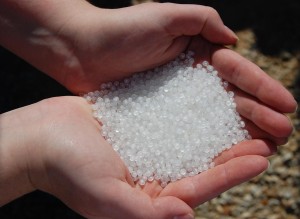These tiny bits of plastic, smaller than the width of a pencil eraser, are causing a big problem and Maia McGuire, Florida Sea Grant agent with UF/IFAS Extension in St. Johns and Flagler counties, is proposing a solution.
McGuire was recently awarded a NOAA’s Marine Debris program grant to raise awareness about microplastics in the ocean by creating a statewide citizen science initiative.
As part of her awareness campaign, titled the Florida Microplastic Awareness Project, she will be training Floridians to take water samples to detect the amount of microplastics in coastal waters across the state. The data collected by volunteers will then be put into Google Maps to show the concentration of these particles visually.
The campaign will teach people ways to reduce their personal contribution to microplastic pollution in hopes of reducing the net amount of plastic released into the environment, McGuire said. According to a study published in Science magazine, in 2010 enough plastic entered the ocean globally to fill five grocery bags for every foot of shoreline of the 192 countries studied.
McGuire says one way to reduce your plastic footprint is by selecting and using personal care products that do not contain polyethylene, a type of microbead found in some toothpastes, deodorants, makeup, body washes and facial scrubs.
To collect the data that will be entered into Google Maps, McGuire is training coordinators across the state to teach citizen volunteers to take water samples and detect when plastics are present. Several UF/IFAS and Florida Sea Grant Extension Faculty are among those coordinators.
“The goal of the analysis is not to quantify the total amount of microplastics in the water sample for publication,” McGuire said. “The analysis is primarily to be able to show people that microplastics are present in local waters, and that this is not just a Great Lakes or Pacific Ocean issue as people might think from media coverage.”

Pictured here is a handful of nurdles, the form of plastic that is shipped to manufacturers who then melt it down to make other items like plastic grocery bags. Maia McGuire received a NOAA grant to raise awareness about these and other microplastics that are posing a threat to the health of Florida waters. (Wikimedia Commons photo)
The project will also include an informational website, educational exhibits and workshops. McGuire has also created a pledge form to distribute at outreach events. The pledge sheet will encourage citizens to read the labels on their personal care products and avoid purchasing those containing polyethlylene. As a prompt to help them remember, they will also receive a magnet saying, “I pledge to keep our ocean clean by saying ‘no’ to polyethylene.” McGuire hopes to get at least 1,000 people to sign the pledge form in the first year.
But McGuire says polyethylene is not the only form of tiny plastic in the ocean. Secondary microplastics come from the degradation of larger plastic items, such as water bottles and plastic grocery bags. The microbeads found in personal care products are referred to as primary microplastics, as they are deliberately made as small pieces. Nurdles are another type of primary microplastic. A nurdle is the form of plastic that is shipped to manufacturers who then melt it down to make other items like plastic grocery bags. Nurdles are also the tiny plastic pellets found in Beanie Babies and some pillows.
“It is startling to realize that every piece of plastic ever made still exists. Petroleum-based plastics do not biodegrade,” McGuire said. “They simply break down into smaller and smaller pieces through degradation by ultraviolet light, microbes, or physical or chemical processes. Plastic is inexpensive, and is often used as a filler in products that we would never expect to contain plastic.”
McGuire’s project is set to be funded for two years, but she hope this is just the beginning of a long-term awareness campaign.
“Given the huge amount of plastic entering the ocean every year, estimated at 8 million metric tons in 2010, it is critical that we reduce our use of non-recyclable plastic items and recycle as much as we can,” McGuire said. “It is unrealistic to think that we can remove plastic from the ocean, so each of us needs to work on reducing our personal contribution to the problem. I hope that by showing people what is actually present in our coastal environment, they will make long-term changes in their purchasing and disposal practices.”



